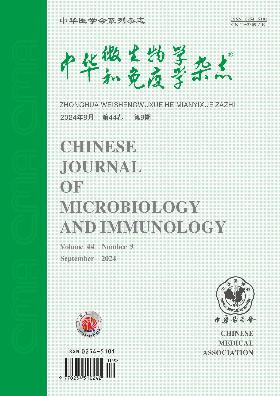靶向表皮生长因子受体(EGFR)和程序性细胞死亡配体-1(PD-L1)的嵌合抗原受体的构建和表达
Q4 Immunology and Microbiology
引用次数: 2
摘要
目的构建表皮生长因子受体特异性嵌合抗原受体(EGFR-CAR)和程序性细胞死亡配体-1(PD-L1)抗体的慢病毒载体表达系统。方法采用人PD-L1-Fc蛋白免疫BALB/c小鼠。通过细胞融合和亚克隆筛选具有高分泌PD-L1特异性抗体的稳定杂交瘤菌株,并通过ELISA和Western印迹进行鉴定。通过荧光激活细胞分选(FACS)测定抗体阻断程序性细胞死亡-1(PD-1)与PD-L1结合的活性。抗体亲和力通过Fortebio Octet96进行分析。通过抗体全长测序和CDR移植法人源化,进一步构建了单链可变片段(scFv)。同时,利用5′RACE技术从分泌抗人EGFR抗体的杂交瘤中克隆出编码轻链和重链可变区(VL和VH)的基因,构建scFv基因。使用pcDNA3.1载体证实scFv的表达。使用2A基因连接含有CD137细胞内功能结构域和PD-L1-scFv的EGFR-CAR。将合成的单分子克隆到pLVX-EF1a-IRES-ZsGreen1慢病毒表达载体中,然后使用Lenti-X包装单针(VSV-G)转染293T细胞以制备感染性病毒。通过FACS和ELISA检测细胞表面CAR的表达和转染293V细胞上清液中PD-L1-scFv的可溶性形式。结果获得了具有高配体受体阻断性能的PD-L1抗体11E3。人源化抗体在将小鼠CDR(CDR1、CDR2和CDR3)直接移植到人框架后显示出稳定的亲和力(2.67×10-10mol/L)。EGFR-scFv以Fc融合的形式有效表达。使用含有EGFR-CAR和PD-L1-scFv的慢病毒载体构建分泌CAR(CTZ0431-1)和膜CAR(CT Z0431-2)表达质粒。293V细胞的感染效率约为10%。用CTZ0431-1感染293V细胞后,检测细胞膜上的EGFR-scFv和培养上清液中的PD-L1scfv。EGFR-scFv和PD-L1-scFv在感染CTZ0431-2的293V细胞的细胞膜上表达。CAR在LV-CART46407-1转染的活化T细胞中的表达率为39.3%。关键词:EGFR-CAR;PD-L1-scFv;膜表达;分泌表达;合成生物技术本文章由计算机程序翻译,如有差异,请以英文原文为准。
Construction and expression of chimeric antigen receptors targeting epidermal growth factor receptor (EGFR) and programmed cell death ligand-1(PD-L1)
Objective
To construct an expression system of lentivirus vector encoding epidermal growth factor receptor-specific chimeric antigen receptor (EGFR-CAR) and programmed cell death ligand-1 (PD-L1) antibody.
Methods
Human PD-L1-Fc protein was used to immunize BALB/c mice. Cell-fusion and subcloning were performed to screen stable hybridoma strains with high secretion of PD-L1-specific antibodies, which were identified by both ELISA and Western blot. The activity of the antibodies in blocking the binding of programmed cell death-1 (PD-1) to PD-L1 was determined by fluorescence-activated cell sorting (FACS). Antibody affinity was analyzed by Fortebio Octet96. A single-chain variable fragment (scFv) was further constructed after antibody full-length sequencing and humanization using CDR grafting method. Meanwhile, the genes encoding the light and heavy chain variable regions (VL and VH) were cloned from a hybridoma secreting antibody against human EGFR by 5′ RACE technology to construct scFv gene. The expression of scFv was confirmed using pcDNA3.1 vector. EGFR-CAR containing CD137 intracellular function domain and PD-L1-scFv was ligated using 2A gene. The synthetic single molecule was cloned into pLVX-EF1a-IRES-ZsGreen1 lentivirus expression vector, and then transfected into 293T cells using Lenti-X Packaging Single Shots (VSV-G) to prepare infectious virus. Expression of CAR on cell surface and the soluble form of PD-L1-scFv in the supernatant of transfected 293V cells were detected by FACS and ELISA.
Results
A PD-L1 antibody named 11E3 with high ligand-receptor blocking performance was obtained. The humanized antibody showed a stable affinity (2.67×10-10 mol/L) after directly grafting the mouse CDRs (CDR1, CDR2 and CDR3) to human frameworks. EGFR-scFv was effectively expressed in a form of Fc-fusion. Secretory CAR (CTZ0431-1) and membrane CAR (CTZ0431-2) expression plasmids were constructed using lentivirus vector containing EGFR-CAR and PD-L1-scFv. The infection efficiency in 293V cells was around 10%. EGFR-scFv on the cell membranes and PD-L1-scfv in the culture supernatants were detected after 293V cells were infected with CTZ0431-1. EGFR-scFv and PD-L1-scfv were expressed on the cell membranes of 293V cells infected with CTZ0431-2. The expression rate of CAR in LV-CART46407-1-transfected activated T cells was 39.3%.
Conclusions
The lentivirus vectors co-expressing EGFR-CAR with moderate binding affinity and PD-L1-scFv with high binding affinity were successful constructed, which provided an essential tool for investing EGFR- and PD-L1 double targeted CAR-T cell therapy against solid tumor.
Key words:
EGFR-CAR; PD-L1-scFv; Membrane expression; Secretory expression; Synthetic biotechnology
求助全文
通过发布文献求助,成功后即可免费获取论文全文。
去求助
来源期刊

中华微生物学和免疫学杂志
Immunology and Microbiology-Virology
CiteScore
0.50
自引率
0.00%
发文量
6906
期刊介绍:
Chinese Journal of Microbiology and Immunology established in 1981. It is one of the series of journal sponsored by Chinese Medical Association. The aim of this journal is to spread and exchange the scientific achievements and practical experience in order to promote the development of medical microbiology and immunology. Its main contents comprise academic thesis, brief reports, reviews, summaries, news of meetings, book reviews and trends of home and abroad in this field. The distinguishing feature of the journal is to give the priority to the reports on the research of basic theory, and take account of the reports on clinical and practical skills.
 求助内容:
求助内容: 应助结果提醒方式:
应助结果提醒方式:


